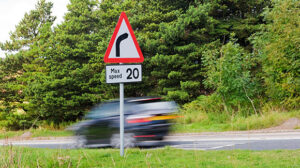What happens if you drive in a bus lane by mistake?
- Editorial Team
Sometimes, motorists unintentionally drive in a bus lane, especially if they are unfamiliar with the roads or travelling in an unfamiliar area.
Bus lanes are designated lanes on the road reserved for buses to use. These lanes are typically defined by signs and road markings that indicate which vehicles are permitted to use the bus lane. Signs are usually placed ahead of the bus lane, clearly indicating the days and times of when the lane is reserved for buses. This is to ensure drivers are aware of the operating hours.
Outside of these designated times, other vehicles, such as cars and motorcycles, may be allowed to use the lanes for regular travel.
Motorists should pay attention to the signage and follow the rules regarding lanes. Driving in a restricted bus lane could result in a penalty fine.
The purpose of these lanes is to give priority to buses so that they can travel more freely without getting stuck in heavy traffic.

How do you know you’re in a bus lane?
Identifying a bus lane is usually straightforward. The presence of certain markings and signs helps drivers recognise when they are entering a bus lane.
Bus lanes are clearly marked with solid white lines and wording, which can be seen multiple times along each lane. Before the bus lane, there are signs indicating its operating hours. If the sign does not display specific times, the bus lane is operational 24 hours a day.
Within the bus lane, there may be sections of broken white lines. These indicate where crossing the bus lane is allowed, such as making a left turn.
A bus gate is a short section of a street or a road that only buses and other authorised vehicles can use. Bus gates are typically marked with clear signage and wording on the road surface.
What are the penalty charges for driving in a bus lane?
The local authority responsible for the road usually sets the penalty charges for driving in a bus lane. The Penalty Charge Notice (PCN) can vary depending on the specific location of where the traffic infringement occurred. For instance, in London, the fine can be up to £130 (or up to £70 outside London).
Some local authorities may reduce the fine if it is paid within a specified timeframe, for example, within two weeks of the notice date. In some areas, the police will issue a fixed penalty notice for bus lane contraventions. However, in most cases, the primary responsibility for enforcing bus lane contraventions lies with the local authorities.
Can you get points for driving in a bus lane?
Driving in a bus lane does not typically result in penalty points on your driving licence, as these points are usually associated with more serious driving offences, like speeding.
How to appeal a bus lane fine?
You can challenge or appeal against the PCN if you believe you should not have received it. To do so, you usually contact the local authority responsible for issuing the charge notice within the specified time limit, usually 28 days after receiving the notice. The PCN should provide details of how to appeal and by when.
There are several reasons you may consider appealing a bus lane fine, such as:
- The alleged infringement did not occur.
- You were not the registered owner/keeper of the vehicle when the infringement took place. You’ll need evidence, like a receipt and a copy of the DVLA registration form, to prove that you weren’t the owner.
- Someone else was driving the vehicle without your permission. If you can prove that someone else was driving your vehicle without your consent, it can be a valid reason to appeal the charge.
- The same offence has already been addressed through a fixed penalty notice or is the subject of ongoing legal proceedings.
- The penalty charge notice exceeds the appropriate amount.
When appealing, it’s important to follow the instructions on the charge notice and gather as much evidence or information as possible to support your case.
How do bus lane cameras work?
Bus lanes are monitored and enforced through cameras, which record the registration number of all vehicles using bus lanes. The cameras are positioned along the bus lanes and help the local authorities track who uses the bus lanes.
If an unauthorised vehicle is captured by a camera driving in a bus lane, a PCN will be sent to the vehicle’s registered keeper.
Can you park in a bus lane?
In general, parking in a bus lane is not allowed. This rule applies to activities such as picking up or dropping off passengers and delivering or collecting goods from premises next to the bus lane.
Parking in a bus lane can disrupt the movement of buses, create congestion, and hinder the efficiency of public transport services. Blocking the designated lane may also pose a safety risk for other road users.
Parking restrictions may vary depending on the local authority. Some areas may have specific times or circumstances when parking in a bus lane is permitted, such as during certain hours when the bus lane is not operating. However, it is generally best to find somewhere else to park to avoid any potential fines.
How long does it take for the bus lane fine to come through?
The exact timeframe for a bus lane fine to come through can vary from a few days to a couple of weeks depending on various factors such as, administrative issues backlogs, challenges in identifying the driver, or postal delays may affect the processing time. Once the PCN is prepared, it is typically sent by mail to the registered owner’s address
It’s worth noting that local authorities must issue the PCN within 28 days of the alleged infringement.
What is the 20-meter rule when driving in bus lanes?
The theory behind the 20-metre rule is that if a motorist accidentally enters a bus lane and travels less than 20 meters before exiting, they generally won’t receive a fine. In such cases, there is usually an understanding that motorists can make mistakes and are allowed to travel a short distance in the bus lane before correcting their error and leaving without penalty.
However, it’s ultimately up to the relevant local authority to determine whether a fine should be issued for driving in a bus lane, regardless of the distance travelled.
How to pay a bus lane fine
There are several ways to pay a PCN.
Online
Many local authorities provide an online payment system where you can pay the fine using a debit or credit card. The payment portal is usually accessible via a link on their official website.
By phone
Some local authorities may provide a phone payment option. The PCN will provide a phone number you can call to make the payment. You will need to provide the reference number mentioned on the PCN and pay using a credit or debit card over the phone.
By post
If you prefer to pay by post, the PCN will typically include instructions on making a payment via cheque or postal order. Follow the guidelines provided, including making the payment to the correct address and ensuring that the payment is received within the specified timeframe.
It’s important to remember that each PCN may have specific instructions and deadlines for payment. Therefore, carefully read the details on the PCN and follow the payment instructions accordingly.
Final thoughts
To avoid unintentionally driving in a bus lane, motorists should pay attention to road signs and familiarise themselves with the routes they will be travelling. By preparing for their journey beforehand and knowing the locations of the bus lanes, drivers can reduce the likelihood of entering a bus lane and receiving a penalty fine.
Share this article
Table of Contents
More posts

What Happens If You Speed With A Black Box?

UK Speed Limits: Here’s What You Need To Know

Too Close For Comfort! Tailgating, Here’s What You Need To Know

